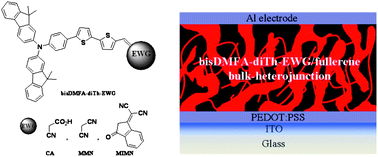Molecular engineering of push-pull chromophore for efficient bulk-heterojunction morphology in solution processed small molecule organic photovoltaics†
Abstract
The synthesis and characterization of new push-pull

* Corresponding authors
a
Department of Advanced Material Chemistry, Korea University, Chungnam, Korea
E-mail:
jko@korea.ac.kr
Fax: +82-41-860-5396
Tel: +82-41-860-1337
b Department of Chemistry, Korea National University of Education, Chungbuk, Korea
c Department of Green Energy Engineering & Research Center for Convergence Technology, Hoseo University, Chungnam, Korea
The synthesis and characterization of new push-pull

 Please wait while we load your content...
Something went wrong. Try again?
Please wait while we load your content...
Something went wrong. Try again?
H. M. Ko, H. Choi, S. Paek, K. Kim, K. Song, J. K. Lee and J. Ko, J. Mater. Chem., 2011, 21, 7248 DOI: 10.1039/C1JM10667H
To request permission to reproduce material from this article, please go to the Copyright Clearance Center request page.
If you are an author contributing to an RSC publication, you do not need to request permission provided correct acknowledgement is given.
If you are the author of this article, you do not need to request permission to reproduce figures and diagrams provided correct acknowledgement is given. If you want to reproduce the whole article in a third-party publication (excluding your thesis/dissertation for which permission is not required) please go to the Copyright Clearance Center request page.
Read more about how to correctly acknowledge RSC content.
 Fetching data from CrossRef.
Fetching data from CrossRef.
This may take some time to load.
Loading related content
